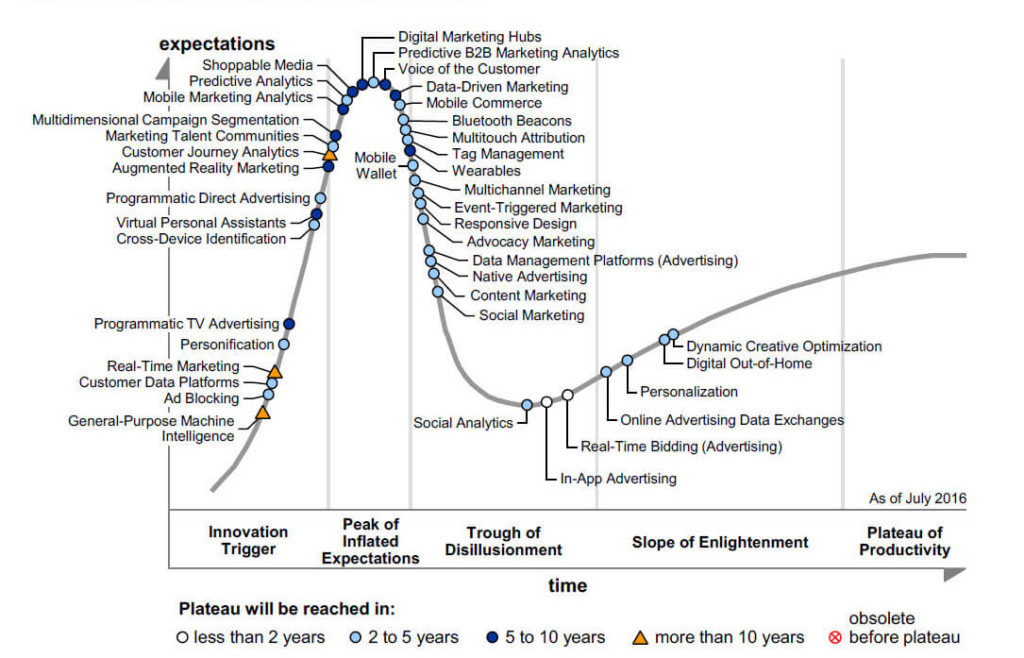Beginning of November 2016 Gartner published his Hype Cycle for Digital Marketing & Advertising, 2016. This gives a direction at which stage topics are in the market and how long they will take to reach productivity.

Let’s have a look at some points which I think are important to have a look at.
Customer Data Platforms (2-5 years)
One of the most important points just at the beginning of the curve. It is not only about online data, it’s about all customer data (own, paid, earned), online and offline. This data we will need for all type of communication, doesn’t matter if it is content, branding, advertising or e-commerce. It will not be about having the best (digital) marketing solution, it will be about the best user understanding. Assuming that products in your market will be comparable, you will win against your competitor if you have the best data and the bets understanding of these data. Don’t care about what’s the best Digital Marketing Hub. Data are the base for your analytics system. Don’t think about Webanalytics, think about a BI and / or a Predictive Modeling System.
Real-Time Marketing (more than 10 years)
Real-Time Bidding (RTB) and Real-Time Advertising (RTA) are still there, so why does it take more than 10 years for Real-Time Marketing (RTM)? Marketing is more than advertising, it’s the entire communication with an user / customer we need to have a look at. Today we have, more or less, just learned how to place an ad by bidding for it. Today we can do real-time for sure, but the decision what will be shown is based on less and simple information. The real power will come if we have a full profile with predictive information behind which a RTM / RTA system can use. Real-Time Marketing is depending on data, customer data platforms, BI systems with predictive analytics, etc.
Personification (2-5 years)
On every marketing conference in 2016 everyone was talking about customer centric. IoT (Internet of Things) which is another word going around contains 3 areas, one is customer experience. Customer centric is a key element for customer experience. Gartner describes Personification this way: “Personification bridges the gap between broad-reach branding efforts like content marketing and true 1-to-1 interactions, which should always be under control of the customer.” 1)Gartner (Andrew Frank): The Personification of Digital Marketing https://blogs.gartner.com
Cross-Device Identification (2-5 years)
Fundamental to build profiles and do data driven marketing. Cookies are still present, fingerprints are less used these days. With the broad reach of fingerprints it’s much more easy merge different devices because a fingerprint is lasting longer and it’s always the same everyone uses. A cookie is a cookie from Google, Facebook, an advertiser, etc.
Programmatic Direct Advertising (2-5 years)
Traditional direct marketing campaigns are not made for real-time. With Programmatic Direct advertising they can use programmatic without the real-time part. Programmatic Direct is a part of programmatic media buying. While Real-Time Marketing lower the cost, they are fixed with Programmatic Direct. Programmatic Direct raises the conversion rate and assures more control of advertising and the brand.
Customer Journey Analytics (more than 10 years)
We started in media buying with booking of environments, then we switch to interests and in future it will be a predictive 1:1 targeting. With this I personally think customer journey is not longer relevant the way we use it these days to rate channels. The customer journey will be more the phase in which a profile is right now and how to bring someone from interest in something to the information and buying stage for example. There are still solutions out today to do so. They will grow with the amount of data and predictive technology coming up.
Predictive Analytics (5-10 years)
Webanalytics and BI systems will merge and we will see AI (artificial intelligence) coming up more and more in all areas. This will raise the possibilities of predictive and bring us to the stage of predictive media buying. Data availability, legal aspects and the change process in each one of us is needed. This will take time.
Data Driven Marketing (5-10 years)
Collecting data, merge them and make them usable is a huge project for many. Some data are needed in raw format, some in an aggregated format, some in real-time and some in near-time. Marketing defines the use of data but the lack of technology and the legal issues defines the speed Data Driven Marketing reaches the plateau of productivity.
Marketing is not just advertising, marketing is also branding, content and (e[/ref]commerce. All this areas can be driven and executed data driven.
***
There are much more relevant topics like Multi-Channel Marketing or Data Management Platforms for example. We all know this very well, that’s why I do not want to step in all of them. It is interesting where Garner sees all this points and what they think how long it will take to reach plateau of productivity. Looking forward how this hype cycle will look in 2017
Do you understand in all points why Gartner thinks so and do you agree them? I’m happy to read your comments here!
References
| ⇡1 | Gartner (Andrew Frank): The Personification of Digital Marketing https://blogs.gartner.com |
|---|
